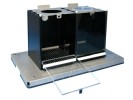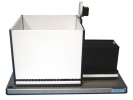Authors
V. Bouet, T. Freret, S. Ankri, M. Bezault, S. Renolleau et al.
Lab
University of Caen Basse-Normandie, Memory and Behavioural Plasticity Group, Caen, France.
Journal
Behavioural Brain Research
Abstract
Among experimental models of perinatal ischemic stroke, Renolleau's model mimics selected types of stroke at birth, including ischemia and reperfusion. However, its behavioural consequences on development have been poorly described. Here, ischemia-reperfusion was performed in 7-day-old Wistar rats. Between the ages of 9 and 40 days, sensorimotor and memory functions were assessed. The infarcted area was analysed by immunohistochemistry at 40 days of age. The remaining lesion was in the parietal cortex, in the form of a cone-shaped area. This area contained glial cells but neither neurons nor macrophages. Transient focal neonatal ischemia led to sensorimotor alterations in early adulthood, such as postural asymmetry, motor coordination and somatosensory deficits, and hyperactivity, as well as cognitive impairments, such as spatial reference memory deficits. Based on these results, we propose here a selection of behavioural tests that should constitute meaningful tools for assessing sensory and cognitive functions after experimental neonatal ischemic stroke.
BIOSEB Instruments Used:
Shuttle Boxes (LE916),Passive avoidance (LE870)

 Douleur - Allodynie/Hyperalgésie Thermique
Douleur - Allodynie/Hyperalgésie Thermique Douleur - Spontanée - Déficit de Posture
Douleur - Spontanée - Déficit de Posture Douleur - Allodynie/Hyperalgésie Mécanique
Douleur - Allodynie/Hyperalgésie Mécanique Apprentissage/Mémoire - Attention - Addiction
Apprentissage/Mémoire - Attention - Addiction Physiologie & Recherche Respiratoire
Physiologie & Recherche Respiratoire
 Douleur
Douleur Système Nerveux Central (SNC)
Système Nerveux Central (SNC)  Neurodégénérescence
Neurodégénérescence Système sensoriel
Système sensoriel Système moteur
Système moteur Troubles de l'humeur
Troubles de l'humeur Autres pathologies
Autres pathologies Système musculaire
Système musculaire Articulations
Articulations Métabolisme
Métabolisme Thématiques transversales
Thématiques transversales SFN2024: Venez rencontrer notre équipe sur le stand 876 à Chicago
SFN2024: Venez rencontrer notre équipe sur le stand 876 à Chicago 
